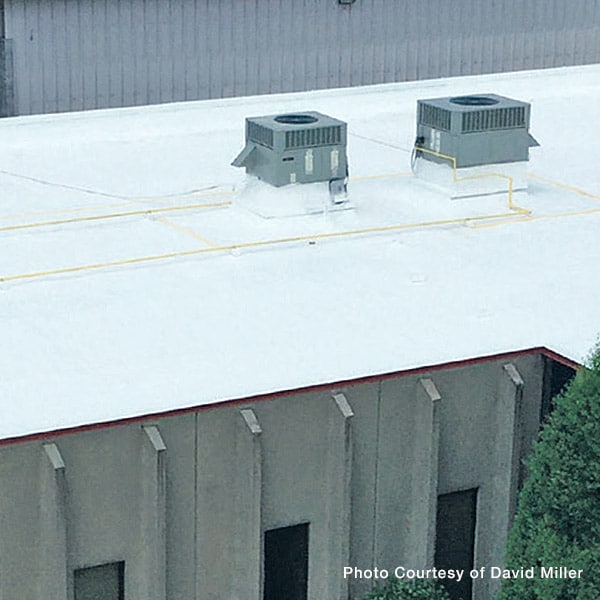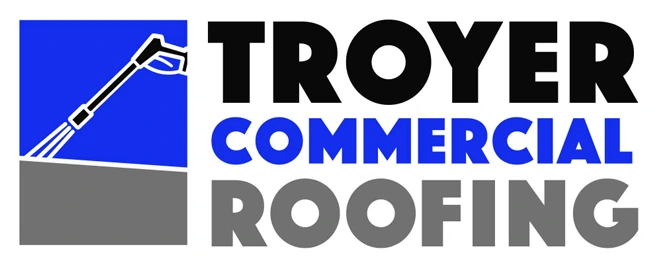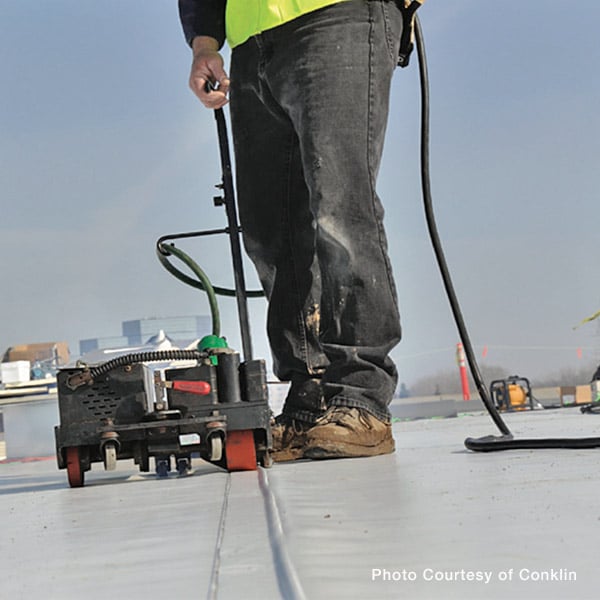Flat Roof Replacement
Whether you are a business owner, or facility manager of a commercial facility, the building most likely has a low slope or flat roof. These buildings have flat roofs due to their cost-effectiveness, easier installation, and the ability for HVAC and communications equipment to be installed on the rooftop. This avoids taking up the valuable interior or exterior commercial space. If this describes your commercial building, then premature flat roof replacement will be of concern to you for your commercial structure.

Avoid Future Flat Roof Replacements
Fortunately, Troyer Commercial Roofing has a more cost-effective solution to avoid the need for costly tear-offs and flat roof replacements. We use the Conklin’s Flexion® single-ply flat roof replacement system with leak-free protection. Conklin’s exclusive white reflective elastomeric coatings are specifically formulated for TPO, PVC, modified bitumen, and approved flat roof membranes. They cover concrete, steel, and wood roof decks. Its exceptional durability, energy efficiency, and rugged leak-free performance instantly stop leaks, restore, and protect aged or weathered membranes eliminating the need for a future flat roof replacement for as long as you own the building. The only maintenance required to keep your flat roof looking its best is an annual clean.
Increased Energy Efficiency Saves Utility Costs
While many roofing materials absorb much of the sun’s UV rays as heat, Conklin’s white reflective “cool roof” coatings reflect over 80% of UV radiation, reducing roof surface temperature as much as 80°F. A cooler roof means a much cooler and more comfortable working interior environment. The significant reduction in heat absorption will reduce cooling costs by 30%. It will also reduce wear and tear on HVAC equipment. Also, an insulation layer will keep your interior spaces warmer in the winter, so Conklin’s flat roof coatings will save utility costs throughout the year. Conklin’s flat roof coatings are rated by EnergyStar and the Cool Roof Rating Council (CRRC). We use FM-approved coating systems.
Exceptional Weather Protection
Conklin’s Flexion® PVC single-ply flat roof replacement system creates an exceptionally durable, weather-resistant membrane with superior solar reflectivity and energy efficiency that outperforms many other roofing materials. Plus, it offers outstanding resistance to water, wind, hail, and fire, even in Florida’s harsh subtropical climate.
Some of the many benefits of our commercial flat roof replacement services:
- Superior waterproofing protection, which stops and prevents leaks in flat roofing.
- Outstanding weather resistance to salty air, wind and hail.
- Superb reflectivity protects the roof from the damaging effects of the sun’s UV rays.
- High energy efficiency reduces up to 30% of cooling costs and gives your air conditioner much-needed relief.
- The sustainable and renewable elastomeric coating eliminates future roof replacements.
- EnergyStar, Cool Roof Rating Council (CRRC) rated, and FM Approved.
- An (up to) 20-year non-prorated guarantee on workmanship and coatings (depending on the coating chosen) is available.
Commercial Flat Roof Replacement in Southwest Florida
For a limited time, Troyer Commercial Roofing is offering FREE roof inspections for agricultural, industrial, manufacturing, and other commercial buildings. We service Bradenton Beach, Ellenton, Siesta Key, South Sarasota, Whitfield, and surrounding communities in Florida. Call to schedule an appointment and free estimate for a flat roof replacement today!
10 Signs You Need A Flat Roof Replacement Or Restoration
1. Persistent Leaks
If your flat roof consistently develops leaks despite repeated repairs, it may be time for a flat roof replacement. Water seeping into the building through cracks or seams can cause structural damage and costly interior repairs. Regular patchwork only provides temporary fixes, so when leaks become more frequent and widespread, replacing the entire roof may be the best long-term solution. A new flat roof will offer superior waterproofing protection, reducing the risk of further damage from water infiltration.
2. Pooling Water
One of the most common issues with flat roofs is water pooling, or ponding, which occurs when the roof doesn’t drain properly. If water remains on the surface for more than 48 hours, it can weaken the roofing material, leading to leaks, sagging, or structural damage. When drainage issues persist despite repairs, it may be time for a flat roof replacement. A new roof will correct the slope and improve drainage, preventing future water accumulation and extending the roof’s life.
3. Blistering or Bubbling
Blistering or bubbling of the flat roof membrane is a clear sign of trapped air or moisture beneath the surface. This is often a result of prolonged exposure to extreme temperatures or improper installation. Over time, these blisters weaken the roof’s ability to protect against water and weather, making it more susceptible to leaks and damage. If blistering becomes extensive and affects large areas of the roof, a flat roof replacement is necessary to restore its structural integrity and prevent further deterioration.
4. Worn or Damaged Membrane
As flat roofs age, the membrane that provides waterproofing protection can become brittle, cracked, or worn. This degradation reduces the roof’s ability to prevent water intrusion, increasing the risk of leaks. If the membrane shows visible signs of wear, such as cracks, punctures, or thinning, it may be time for a flat roof replacement. A new membrane will restore the roof’s durability, ensuring better protection against the elements and extending the building’s overall lifespan.
5. Roof Sagging or Structural Issues
Flat roofs are designed to handle certain amounts of weight, but sagging can indicate structural issues beneath the surface. This could be caused by prolonged water pooling, heavy snow, or even structural damage to the underlying support system. When sagging occurs, the roof is no longer able to function as it should, compromising the building’s safety. In this case, a flat roof replacement is essential to address both the surface and the structural integrity of the roof.
6. Extensive Repairs Required
If your flat roof requires frequent or costly repairs to address recurring issues like leaks, punctures, or flashing problems, it might be more economical to invest in a full flat roof replacement. Constant maintenance can add up over time, and at some point, the cost of repairs outweighs the benefits. Replacing the roof will resolve underlying issues and prevent the need for continued patchwork, offering a more durable, long-term solution for your commercial building.
7. Interior Damage
Visible damage inside the building, such as water stains, mold growth, or peeling paint on walls and ceilings, can be a sign that the flat roof has failed. When water penetrates the roof membrane and affects the interior, it compromises the structural safety and can lead to expensive repairs. If you notice significant interior damage linked to roof leaks, a flat roof replacement is likely the best solution to protect the building from further water damage and restore a safe, dry environment.
8. Deteriorating Flashing
Flashing around roof edges, vents, and skylights is critical for preventing water penetration. Over time, flashing can deteriorate due to weather exposure, causing gaps or cracks that allow water to seep in. If you notice that the flashing is corroded, cracked, or separated from the roof, it may be time for a flat roof replacement. Installing new flashing as part of a complete roof replacement will help ensure a watertight seal and prevent future water intrusion.
9. Roof Age
Flat roofs typically have a lifespan of 20 to 30 years, depending on the material and maintenance. If your roof is approaching or has exceeded its expected lifespan, it may no longer provide reliable protection against weather and water damage. Even if there are no visible signs of damage, an older roof is more prone to leaks and structural issues. In such cases, a flat roof replacement can ensure that your building remains safe, energy-efficient, and protected from the elements.
10. Energy Inefficiency
If your energy bills are rising and your building feels warmer or cooler than usual, your flat roof may be contributing to energy inefficiency. Worn or damaged roofing materials can reduce insulation, allowing heat to escape in the winter and enter in the summer. A flat roof replacement with energy-efficient materials, such as reflective coatings, can help lower utility costs by improving the roof’s thermal performance, reducing heat absorption, and keeping the building’s interior more comfortable.
Flat Roof Replacement vs Restoration
When deciding between flat roof replacement and restoration, it’s essential to understand the key differences in cost, time, and long-term benefits. A flat roof replacement involves tearing off the existing roofing materials and installing a completely new system. This process is more labor-intensive and expensive, but it’s often necessary when the roof is beyond repair or has reached the end of its life. Replacement offers the advantage of a brand-new roof with advanced materials, ensuring durability and improved performance.
On the other hand, flat roof restoration is a less invasive and more cost-effective solution for roofs that are still structurally sound but showing signs of wear. Restoration involves applying EPDM roof coatings or other specialized materials to seal the roof, fix minor damages, and prevent leaks. This method can extend the roof’s life by 10-15 years without the need for a costly tear-off. Restorations also provide energy savings through reflective coatings and can qualify for tax incentives or rebates.
10 Maintenance Tips To Avoid A Flat Roof Replacement
1. Schedule Regular Roof Inspections
Routine roof inspections are vital for preventing damage that can lead to a flat roof replacement. Have a professional inspect your roof at least twice a year, especially after severe weather events like storms or hurricanes. Inspections can identify early signs of wear, leaks, or membrane damage. By catching these issues early, you can make necessary repairs, extending the life of your roof. This proactive approach helps prevent costly replacements and ensures the roof remains in good condition for as long as possible.
2. Clean Gutters and Drains
Clogged gutters and drains can cause water to pool on your flat roof, leading to structural damage and leaks. Over time, standing water increases the risk of a premature flat roof replacement. To avoid this, regularly clean your gutters and downspouts to ensure proper drainage, especially after heavy rain or storms. Proper water flow prevents moisture buildup on the roof’s surface, which can extend the life of your roof by reducing the chances of water-related damage.
3. Remove Debris
Debris such as leaves, branches, and dirt can accumulate on your flat roof, trapping moisture and causing damage to the roofing membrane. This debris can also block drainage points, increasing the risk of ponding water. To avoid a flat roof replacement, regularly remove debris, especially after storms or high winds. Clearing the roof of unwanted materials prevents excess moisture from deteriorating the membrane, protecting the roof from leaks and extending its lifespan, which helps avoid costly repairs or replacements.
4. Address Ponding Water Immediately
Ponding water on a flat roof can lead to serious damage over time. Water that remains on the surface for more than 48 hours may cause the roofing membrane to weaken, increasing the risk of leaks or structural damage. To avoid flat roof replacement, address ponding water as soon as it occurs. Improving drainage or adding tapered insulation can help prevent water buildup. Immediate attention to water pooling ensures that your roof remains intact and reduces the risk of long-term deterioration.
5. Repair Small Leaks and Cracks Early
Even small leaks or cracks in your flat roof can grow into more significant problems if not repaired promptly. Water seeping through minor cracks can weaken the membrane, causing internal damage that could lead to the need for a full flat roof replacement. Repairing these small issues early with materials like EPDM roof coatings can seal and protect the surface. Addressing minor repairs before they escalate is key to preserving the roof’s integrity and extending its lifespan, avoiding unnecessary replacement.
6. Trim Overhanging Trees
Overhanging tree branches can scrape or puncture a flat roof, especially during storms or high winds. Branches that fall onto the roof can cause significant damage to the membrane, leading to leaks or weakening the structure. To avoid the need for a flat roof replacement, regularly trim any trees near the building to prevent them from damaging the roof. Keeping the roof clear of debris from nearby trees will reduce wear and tear, preserving the roof’s longevity and protecting it from severe damage.
7. Ensure Proper Ventilation
Proper roof ventilation helps to prevent moisture buildup inside the building, which can lead to mold, mildew, and weakening of the roofing materials. Without adequate ventilation, trapped moisture can damage the roof from the inside out, potentially requiring a flat roof replacement. Ensuring good ventilation reduces the risk of internal condensation, prolongs the life of the roofing membrane, and maintains the structural integrity of the roof. This simple maintenance step can help avoid costly damage and improve overall roof performance.
8. Apply Reflective Roof Coatings
Applying reflective EPDM roof coatings is an excellent way to protect your flat roof and avoid premature flat roof replacement. Moreover, these coatings reflect UV rays, reducing the roof’s surface temperature and preventing heat-related damage such as cracking or warping. In addition to prolonging the life of the roof, reflective coatings also improve energy efficiency by lowering cooling costs, especially in warmer climates. By using these coatings, you can protect the roof from sun damage, while making your building more energy-efficient.
9. Regularly Inspect Roof Seams and Flashing
Seams and flashing on a flat roof are common points where water can enter, leading to leaks and moisture damage. Over time, these areas can wear down or become separated, increasing the risk of needing a flat roof replacement. Regular inspections of these vulnerable spots can help you catch early signs of wear and tear. If damage is found, repair it immediately to prevent leaks. Keeping seams and flashing in good condition extends the roof’s lifespan and reduces the need for major repairs.
10. Keep Foot Traffic to a Minimum
Lastly, excessive foot traffic on a flat roof can cause significant wear and tear, leading to punctures or membrane damage. This increases the likelihood of leaks and other issues that may require a flat roof replacement. Hence, to avoid unnecessary damage, limit foot traffic on the roof and use designated walkways or protective mats when access is necessary. Reducing foot traffic will help preserve the roof’s surface, maintain its structural integrity, and extend its lifespan, minimizing the need for costly repairs or replacements.

